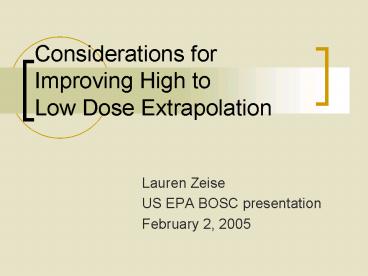Considerations for Improving High to Low Dose Extrapolation - PowerPoint PPT Presentation
1 / 22
Title:
Considerations for Improving High to Low Dose Extrapolation
Description:
Single number characterizes entire dose response relationship. No risk estimation and low dose prediction ... Days since conception % with tumor. Birth ... – PowerPoint PPT presentation
Number of Views:510
Avg rating:3.0/5.0
Title: Considerations for Improving High to Low Dose Extrapolation
1
Considerations for Improving High to Low Dose
Extrapolation
- Lauren Zeise
- US EPA BOSC presentation
- February 2, 2005
2
Considerations for improvements in
- Non-cancer dose response
- Cancer risk assessment
- Modeling and characterization processes
3
Non-cancer dose response characterization issues
- Single number characterizes entire dose response
relationship - No risk estimation and low dose prediction
- Threshold dose response nearly always assumed
- Background exposure not typically considered
4
RfD from typical experiment Adjusted NOAEL or
Benchmark Dose
NOAEL
BMD
5
Low dose risk estimation Probabilistic RfD
method
- Adjustment uncertainty factors are probability
distributions - Human non-cancer dose response is a dose vs. risk
function - RfD is dose at a de minimis risk level
- Uncertainty in RfD estimated
6
Construction of probabilistic dose response
ED01 Distribution
7
US EPA Dioxin Risk Assessment Recognition of
background
- Recognizes background exposures
- Does not establish RfD
- Characterizes the margin of exposure
- exposure inducing 1 risk
- human background exposure level
Nursing Infant
8
Background Exposures
Risk
Axis translation
9
Non-carcinogenic effects where threshold not
apparent
...recent epidemiological studies ... suggest
that there is no threshold concentration for O3,
Pb, and PM
- Lead
- PM
- Ozone
- Methylmercury
- Arsenic
- Benzene
National Research Council, 2004
10
Cancer Dose Response
11
Creating tools to translate biological data on
variability into mathematical models of human
cancer risk
12
Combining models of human variability and cancer
13
Total risk when agent causes cancer at multiple
sites
Needed Tools to calculate lower bounds on e.g.
ED01 and ED10
Dimethoxybenzidine
14
Rodent Bioassays Dosing Periods and Critical
Windows
Standard Assay
conception
birth
3 years
2 years
6 wks
8 wks
15
Tumors of nervous system in rats treated with
N-ethylnitrosourea (ENU) at different ages (Naito
et al., 1981)
Total nerve tumors
Birth
McDonald, 2002
16
Background exposures, non-linear carcinogens,
incomplete carcinogens
17
Probabilistic RfD compared to EPA standard cancer
assessment
- Non-cancer Prob RfD
- Threshold model
- Individual thresholds vary Variable
susceptibility addressed - Background exposures ignored
- Uncertainty expressed as probability distribution
- Cancer
- Non-threshold model
- Variability in susceptibility not addressed
- Assumes background important
- Full uncertainty in estimates typically not
modeled
18
Harmonization of cancer and non-cancer approaches
- Limitations in both approaches
- Expand existing approaches to more optimal
harmonized approach? Explore new approaches? - Address background, human variability, and
uncertainty - Incorporate qualitative measures of uncertainty
- Some possible critical features chemical
persistence, subtlety of effect, complexity of
toxicological process
19
Terminology
- Uncertainty Variability
- NOAEL NOEL
- Uncertainty Factor Adjustment Factor
- Non-linear Linear Low dose linear
Supralinear
Sublinear
Low Dose Linear
20
Mechanistic models and pharmacokinetic model
adjustments for high to low dose extrapolation
Model series of differential equations
21
Developments for pharmaco- kinetic and dynamic
models
- Site specificity assumption
- Model and parameter uncertainty characterization
(e.g., hierarchical Bayesian approach) - Statistical evaluation
- Overall model validation
- Expert review
22
Risk Management Considerations
- Dose response so that risk characterizations
adequately inform decision making - Support routine decision making (e.g.,
permitting) - Support decision making broad in scope
National Research Council, 1996































